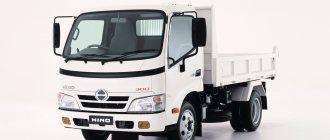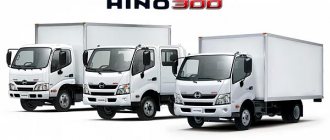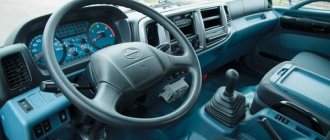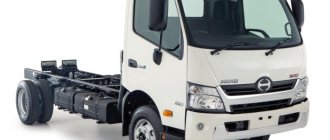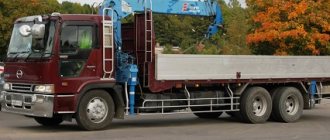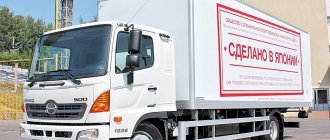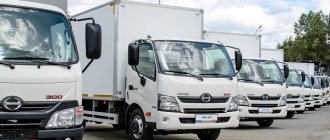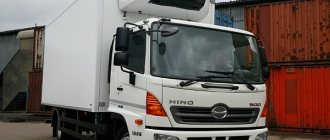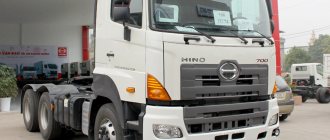Hino Ranger is a family of medium-duty cabover trucks, the production of which began in 1969. The creator of the model is the Japanese brand Hino Motors (a subsidiary of Toyota Motor). The family is usually divided into 2 large groups of cars with a gross weight of 7.5-8 tons and over 10 tons. Light models have a length of up to 12 m and code names FC, FD, FE, FF, FG, FL, FM. The further the second letter in the alphabet, the greater the truck's payload capacity. All-wheel drive is installed exclusively in the FT and GT versions.
Hino Ranger competed in the Dakar several times, finishing well in the top ten. The family is currently out of production. In the brand's model range they were replaced by the 500 series.
Engine characteristics
Hino Neavy Industry Co Ltd began producing diesel power units back in the 40s of the last century. Then the company merged with Toyota, which specialized in the production of medium-duty and heavy-duty trucks.
Motors of this series have been produced for more than 10 years. The technical features are as follows.
| What does it eat? | diesel, diesel |
| Maximum power that can be developed, l. With. | 260 |
| Rotation torque, rpm | 1500 |
| engine's type | in-line, 6-cylinder |
| Number of valves | 24 |
| Injection type | direct, common ryle |
| Turbine | available |
| How the camshaft is driven | from the crankshaft through the intermediate gears |
| How to adjust valve clearances | special screw |
| Oil pan | steel, stamped |
| Piston pins | floating, secured with retaining rings |
| Piston material | Aluminium alloy |
| Piston skirt | protected by anti-seize materials |
| cylinder head | SOHC |
Model history and purpose
The Hino Ranger is unfamiliar to domestic car owners, since this family is produced primarily for the Japanese market. In Russia, the model is not often seen. Moreover, there are practically no right-hand drive modifications of the truck.
1st generation
The first Hino Ranger appeared in 1969. The debut generation was produced until 1980. It included several versions with different wheelbases (short, medium, long). The cars were equipped exclusively with diesel units and were rarely exported.
2nd generation
In 1980, the Hino Ranger underwent a deep facelift, after which the second generation of the model was presented to the public. Its production continued until 1989. In Indonesia, the car was produced until 2003. Hino Ranger was supplied to the European and Russian markets in single batches. The cab of the truck resembled the domestic KamAZ (no hood, large bumper and 4 headlights at the bottom). Technically, the second Hino Ranger looked good, but it was not adapted to Russian realities.
3rd generation
Since 1989, the brand began producing the third generation of the model. In the Japanese market, the truck was available in the Space Ranger, Cruising Ranger and Rising Ranger modifications. For the American market, the designation was made up of letters and numbers indicating the version, weight and power of the engine (for example, FF3020). The model was also supplied to Russia. Externally, the third generation differed from its predecessor with smoother lines. The headlights increased in size and were combined into one lampshade. The comfort of using the car has increased due to the use of higher quality materials and a new driver's seat. The number of modifications of the truck has also increased, which has expanded its scope of application.
4th generation
In 2001, the fourth generation of the Hino Ranger premiered. This version with a total weight of 12,000 kg is currently being produced. At the same time, the export variation was called Hino 500. The family includes many modifications with different cabins (variable parameters: bed, width, height), gross weight and wheelbase length. A wide range of add-ons is also available for the chassis. The most popular are:
- isothermal van;
- onboard platform;
- tanker truck (fuel truck, sewer truck);
- refrigerator;
- tow truck with a crane installation or a sliding platform.
Externally, the latest generation of Hino Ranger has retained the features of its predecessor. At the same time, the family began to be equipped with irregularly shaped headlights and a bumper in the color of the cabin.
The scope of application of Hino Ranger is quite wide. Basically, the car is of interest to the commercial segment to perform the following functions:
- transportation of goods of various weights and volumes;
- performing various types of work in the industrial and construction fields;
- transportation of goods requiring special temperature conditions.
The main clients of the model are large retail chains and the commercial segment, but the truck is often used as a personal work vehicle. Low cost and high performance indicators allow it to be used for a variety of purposes.
Hino Ranger, despite its long history, is not so widespread in Russia. However, the model continues to explore a new market, constantly expanding the ranks of its fans.
Pros of the j08c engine
Let's consider the advantages of this power unit:
- Japanese reliability - this company has a lot of experience in the production of heavy engines;
- high power - an excellent opportunity for large trucks and various special equipment;
- direct fuel injection - this ensures high engine efficiency and at the same time efficiency, low noise, and increased torque;
- the presence of one camshaft in the cylinder head means simplicity and low cost of maintenance.
Toyota forklifts
Toyota Tsusho Tekhnika is a leading company in the modern Russian market, supplying specialized warehouse equipment: loaders, forklifts, stackers "TOYOTA". In the future, Toyota Tsusho Tekhnika plans to expand the range of warehouse equipment and include warehouse hydraulic trolleys and TOYOTA automatic warehouses in the supply. Over the past 14 years, we have earned high authority both among thousands of customers, owners of TOYOTA forklifts, and among competitors in the industrial equipment market...
Types of forklifts produced:
Toyota 3FDE160
Nominal load capacity: 16000 kg
Engine:
HINO/H07D
Length:
4750 mm
Height:
3100 mm
Width:
2480 mm
Technical characteristics of Toyota 3FDE160 >>
Toyota 40-7FB15
Nominal load capacity: 1500 kg
Length:
2216 mm
Height:
2105 mm
Width:
1170 mm
Operating power:
10.7–12.2 kW/hp.
Technical characteristics of Toyota 40-7FB15 >>
Toyota 40-7FB20
Nominal load capacity: 2000 kg
Length:
2405 mm
Height:
2160 mm
Width:
1150 mm
Operating power:
10.7–12.2 kW/hp.
Technical characteristics of Toyota 40-7FB20 >>
Toyota 40-7FB25
Nominal load capacity: 2500 kg
Length:
2435 mm
Height:
2160 mm
Width:
1150 mm
Operating power:
10.7–12.2 kW/hp.
Technical characteristics of Toyota 40-7FB25 >>
Toyota 42-7FD15
Nominal load capacity: 1500 kg
Engine:
gas
Length:
2245 mm
Height:
2030 mm
Width:
1070 mm
Technical characteristics of Toyota 42-7FD15 >>
Toyota 42-7FG15
Nominal load capacity: 1500 kg
Engine:
gas
Length:
2255 mm
Height:
2030 mm
Width:
1070 mm
Technical characteristics of Toyota 42-7FG15 >>
Toyota 42-7FG18
Nominal load capacity: 1750 kg
Engine:
gas
Length:
2285 mm
Height:
2030 mm
Width:
1070 mm
Technical characteristics of Toyota 42-7FG18 >>
Toyota 42-7FG20
Nominal load capacity: 2000 kg
Engine:
gas
Length:
2545 mm
Height:
2060 mm
Width:
1150 mm
Technical characteristics of Toyota 42-7FG20 >>
Toyota 42-7FG25
Nominal load capacity: 2500 kg
Engine:
gas
Length:
2600 mm
Height:
2060 mm
Width:
1150 mm
Technical characteristics of Toyota 42-7FG25 >>
Toyota 4FD100
Nominal load capacity: 10000 kg
Engine:
HINO J08E-T
Length:
4200 mm
Height:
2970 mm
Width:
2315 mm
Technical characteristics of Toyota 4FD100 >>
Engine oil
The j08c engine must be filled with at least 13.5 liters of oil when changing. This is based on the calculation that 1.7 liters will go to the filter and 11.5 liters to the crankcase. As for the quality of the lubricant, because of the Common Rail, formulations with strict requirements for sulfated ash content must be filled here. If you turn off the EGR, you can safely pour CJ-4-8. It is recommended to purchase only original Toyota ones.
Description of the book
Repair book Hino engines
Operation of any Hino Engine vehicle is impossible without knowledge of its structure, maintenance and repair features. It doesn’t matter who will carry out the necessary work - every driver is simply obliged to know the basic maintenance and troubleshooting procedures.
The repair book for Hino engines contains all the necessary information that will help the owner understand the structure of the car, teach how to properly care for the car, timely maintenance and proper repairs.
The repair manual for Hino engines is divided into chapters: Vehicle design (describes general information and vehicle specifications); Operating instructions (preparation for departure, recommendations for traffic safety); Malfunctions along the way (tips to help you in case of an unexpected breakdown on the road); Maintenance (detailed recommendations for all maintenance procedures); Repair instructions (engine, transmission, chassis, steering, brake system, and also includes assembly and disassembly work necessary during the repair process of Hino engines); Electrical equipment (detailed manual for diagnosing and troubleshooting, separately describing the main units and providing detailed electrical diagrams for Hino engines).
Any of the repair procedures for Hino engines is given according to the principle from simple to complex: from simple maintenance operations, adjustments, replacement of parts, to global repairs with assembly and disassembly work.
All material in the book is based on specific experience gained from the complete disassembly and reassembly of Hino engines by highly qualified auto mechanics.
Book “HINO H06C, H07C, H07D, EH700, EP100 engines. Repair and Maintenance Manual" is necessary so that diagnostics and repairs of Hino engines can be done professionally and quickly even by the owner of the car who still has little practical experience.
You can download the repair manual for Hino engines for free in pdf format . You just need to download it to your phone or tablet and you can use it in any situation on the road.
Owner reviews
Let's now listen to the owners of cars with this engine.
Yakov Shim, Novosibirsk
“The legendary j08c is the reason I bought my Hino Ranger. A long time ago, when a dollar cost 25 rubles - in March 2008, I managed to purchase a 2002 truck in Vladik. In addition to a reliable internal combustion engine, I got the simplest fuel equipment, ABS, air conditioning, a rear view camera and a cabin without a sleeping bag. What can I say - with such an engine the car is more suitable for the city, since after 2000 rpm the tachometer's white zone begins, and after 3100 - the red zone. However, in principle there is enough speed on the track.”
Zaton, Barnaul
“I once drove a ’95 Hinorem. The cabin was equipped with a sleeping bag and carried all 11 tons (although the rated load capacity is 8 tons). The engine rushes like a tank on flat roads, but on hills you have to change gears more often. Overall, I was happy as an elephant, but the speedometer cable began to wobble, and it kept breaking.”
John, USSR
“Forces are the weak point of this engine. Before finishing off the beam equipment with water, I replaced all the nozzles. Then, carelessly, I poured water into the sump and filter with all the consequences. In general, change the injectors on time - and you will be happy.”
Device
The design of Hino Ranger meets high quality requirements. The cabin is both functional and comfortable. For the driver, the developers have provided a seat with a separate air suspension. A seating area and air conditioning are already available in the basic version. The instrument panel is located quite low, which increases frontal visibility. The driver is located in close proximity to the main switches and controls.
The Hino Ranger is equipped with two types of rear suspension - pneumatic and spring. To reduce the loading height, tubeless low-profile tires with a wheel diameter of 17.5 inches are used. Single leaf springs used in the truck allow you to extend its service life. They feel great on uneven terrain and off-road. Thanks to the reinforced frame design, the correct distribution of increased loads is achieved and the integrity of the structure is maintained.
The owners of the Hino Ranger noticed that the model is capable of carrying a much larger load than the declared one. However, experts do not regularly recommend using a car with a maximum weight limit, as this can end in disaster. The chassis of the vehicle is of improved quality and can last up to 500,000 km without problems, even on Russian roads. For it, it is enough to periodically lubricate some elements.
The Hino Ranger body is coated with special compounds that protect against external influences and corrosion during regular use. The blocks are additionally protected from dirt and dust. This increases the overall work resource. It is adaptation to difficult working conditions that is considered one of the main advantages of a car. So, the truck functions normally on Russian fuel.
In the basic configuration, the Hino Ranger is equipped with a 4-spring cab suspension, air conditioning, electric windows, power steering, sleeper, air suspension and heated driver's seat, fog lights, central locking, heated mirrors, ABS, ASR, pneumatic braking system and an electric cab lift system.
The Hino Ranger is mostly available in right-hand drive versions. Conversion to left-hand drive is very expensive, since adaptation requires the replacement of about 60 elements. In addition to moving the steering, it will be necessary to change the ventilation system, engine shield, headlights, dashboard and move the pedal unit. Economically, this procedure is very unprofitable.
Another disadvantage that drivers regularly complain about is the cold cabin. In sub-zero temperatures, the comfort of working in a car decreases sharply. The stove functions normally in exceptional cases (sometimes replacing antifreeze helps).
Hino Ranger is equipped with a generator without a brush assembly. This design is convenient because it practically does not break. There is no need to purchase additional spare parts for the element. The only thing that can fail is the bearings.
Contract (used) engine J07C-NA for Hino Serie 165 hp 20V 6.6 l Diesel fuel
- Availability: In stock
- Applicability: HINO series
- Description
- Characteristics
- Reviews
- Delivery
This engine is a contract part with excellent quality and technical characteristics.
The J07C-NA engine has been produced since 1900. The contract engine has a minimum mileage and all the necessary documents.
Truck HINO 500
Among the company's products, the HINO 500 truck is the most popular in Russia. It has many modifications that are equipped with additional options and functions that increase productivity in a particular area of work. This special equipment is designed for operation in difficult conditions when it is necessary to quickly perform work operations.
Truck HINO 500
The vehicle belongs to the medium-duty class, is used in commerce, and weighs 12 tons. The manufacturer of the truck is HINO 500, a subsidiary of the Toyota brand, which ensures the quality of Japanese equipment. In terms of the number of cars sold, this model surpasses many competitors. In the Land of the Rising Sun it is called Ranger. When producing equipment, the manufacturer focuses on its high quality. The standard equipment includes a hydraulic power steering column, so driving the machine is easy and relaxed. Smooth acceleration and improved transmission provide excellent maneuverability.
